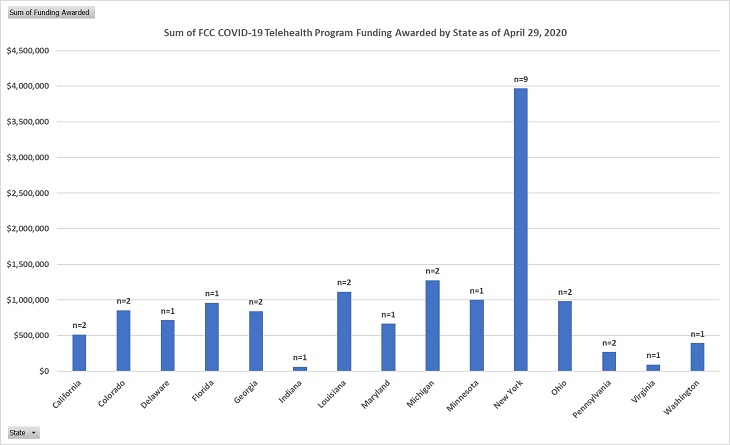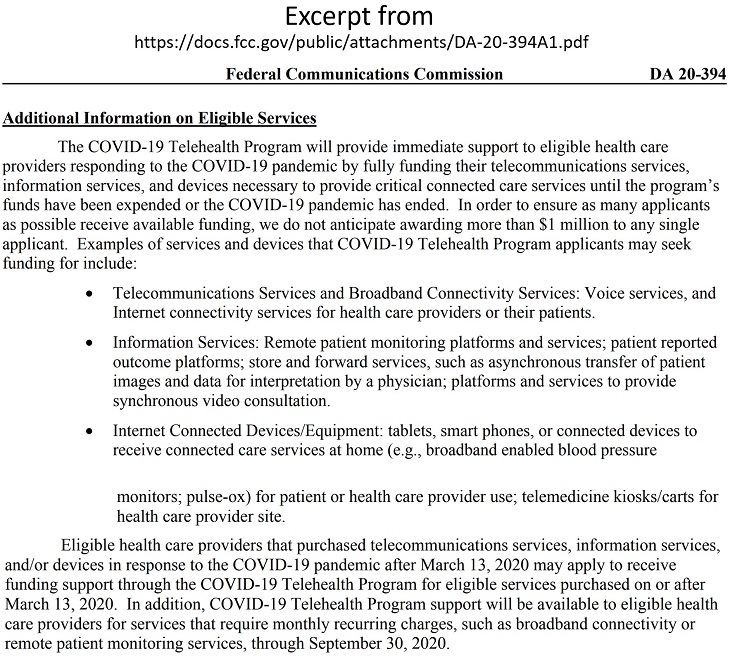The Coronavirus Aid, Relief, and Economic Security (CARES) Act was signed into law by President Trump on March 27, 2020 in response to the COVID-19 public health emergency. The CARES Act provided $200 million to the FCC to support healthcare providers in the fight against the COVID-19 pandemic. On April 2, 2020 the FCC announced its COVID-19 Telehealth Program which provides funding of up to $1 million per applicant to “purchase telecommunications, information services, and connected devices to provide connected care services in response to the coronavirus pandemic.” As of April 29, 2020, the FCC has already awarded 30 applicants from 15 states funding totaling $13,700,581. The average amount awarded is $456,686, with individual funding awards ranging from $26,180 to the maximum of $1,000,000. Per the FCC order, “this funding opportunity will remain available until the funding is expended or the COVID-19 pandemic has ended,” and “applicants that have exhausted initially awarded funding may request additional support.”

The FCC has approved four sets of applications to date. A brief description of the applications awarded is included in each of the four approval announcements: Set 1 (April 16th), Set 2 (April 21st), Set 3 (April 23rd), and Set 4 (April 29th). A review of the awarded project descriptions reveals that this FCC telehealth funding program is different from past FCC telehealth funding programs that were limited to partial subsidy of broadband telecommunications costs for telehealth connectivity. As you can see in the excerpt from FCC’s April 8, 2020 COVID-19 Telehealth Program application guidance document below, the FCC COVID-19 Telehealth Program can fully fund “…telecommunications services, information services, and devices necessary to provide critical connected care services…purchased on or after March 13, 2020.”

Like any funding opportunity, it is essential to determine your eligibility to apply before investing valuable time and resources in completing the application process. Per the FCC order eligible healthcare providers may be located in rural or non-rural areas and are “nonprofit and public eligible health care providers that fall within the categories of health care providers in section 254(h)(7)(B) of the 1996 Act: (1) post-secondary educational institutions offering health care instruction, teaching hospitals, and medical schools; (2) community health centers or health centers providing health care to migrants; (3) local health departments or agencies; (4) community mental health centers; (5) not-for-profit hospitals; (6) rural health clinics; (7) skilled nursing facilities; or (8) consortia of health care providers consisting of one or more entities falling into the first seven categories.” Additional eligibility criteria and application guidance are described in the official FCC COVID-19 Telehealth Program order and the application guidance document.
FCC Chairman Pai, in the April 16th press release announcing the first set of COVID-19 Telehealth Program application approvals, stated “Telehealth has emerged as a critical service for healthcare providers and patients alike during the coronavirus pandemic…It promotes social distancing, protects the safety of health care professionals and patients and frees up space in health care facilities for those who now need it most.” Each virtual telehealth interaction, as compared to in-person healthcare encounters, also preserves valuable personal protective equipment.
Combined with sweeping CMS rule changes and waivers that enable payment for telehealth services rendered by healthcare providers, this FCC funding program is an excellent opportunity for healthcare practices to implement or augment telehealth services to enhance the care they provide to their patients while helping to slow the spread of COVID-19.
For complete FCC COVID-19 Telehealth Program information and related documentation visit: https://www.fcc.gov/covid-19-telehealth-program.

